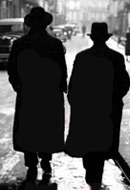At the Edge of the Abyss

Bernard Wasserstein is a non-Zionist historian sympathetic to Israel while critical of its policies. Now based at the University of Chicago, the London-born Wasserstein has focused much of his intellectual energies on matters Jewish. He does so again in On the Eve, a rich and nuanced history of the 10 million Jews of Europe before the Second World War that aims to "capture the realities of life in Europe in the years leading up to 1939, when the Jews stood, as we now know, at the edge of an abyss." The new book is a sort of prequel to his Vanishing Diaspora: The Jews in Europe Since 1945, published 16 years ago.
The striking thesis of On the Eve is that even before Hitler came to power in 1933, the prognosis for European Jewry was bleak: "The demographic trajectory was grim and, with declining fertility, large-scale emigration, increasing outmarriage, and widespread apostasy, foreshadowed extinction. Jewish cultural links were loosening . . . many Jews wanted to escape from what they saw as the prison of their Jewishness." Millions of Jews abandoned Europe in the interwar period—perhaps 10 percent of the Jewish population; many headed to America. Wasserstein's well-chosen epigraph is from historian Simon Dubnow (whose quixotic championing of an autonomous Diaspora-based Jewish nationalism is itself a historical footnote): "The historian's essential creative act is the resurrection of the dead."
Wasserstein proves himself to be most adept at the task. He breathes life into old quarrels, both political and theological: Agudas Yisroel against the Reform; both against the Zionists; the anti-Zionist extremist Hasidim of Satmar against the anti-Zionist fanatics of Munkacz; the General Zionists versus Revisionists, and so on. Economically, most Jews made their living in commerce or in the professions since anti-Semitic strictures essentially closed academia, government, and agriculture to them. Demographically, by the early 1930s most Jews in Germany were marrying out.
Against all this, Wasserstein's portraits of life in heder, niggun-composing Hasidic rebbes, the workings of yeshivot in Mir, Lublin, and Ponevezh, and a sketch of the Mussar movement show an Orthodoxy in decline but no means defeated. It faced minor competition from the non-Orthodox whose Budapest rabbinical school, for example, allowed its seminarians to attend (gasp) the cinema. In much of Europe, the real challenge to tradition came from newfound access to the outside world—while in the Soviet Union it was the jealous god Stalin.
The book is not all doom and gloom. There is a charming segment on Luftmenshn, those who had no visible means of support to sustain their lifestyles which ranged from poor to comfortable. The remarkable devotion of Jewish parents to their children also gets nice treatment. Bit by bit, as the doors were closing, thousands of children were brought to safety in the 1932-33 youth aliyah, the brainchild of a little known heroine named Recha Freier; the Kindertransport later delivered 10,000 children to England.
Wasserstein's treatment of "anti-Jewish Jews" is compelling, given the abundance of ashamed Jews coming out of the woodwork in our own day. In their Selbsthass or self-hatred, some Jews parodied anti-Semitic tropes. Of course, as Wasserstein points out, they did not literally hate themselves so much as they despised other Jews. Some were outspokenly disdainful of the Nazis; most were fixated by Jewish issues; many ultimately renounced Judaism and assailed Jewish solidarity—but paradoxically abhorred Jewish powerlessness. (Except for his gratuitous hatchet job on Ze'ev Jabotinsky, Wasserstein approaches pre-war European Zionism with comparative sympathy.) There is also a sketch of earlier far-Left Jews who had quit Palestine to return to Russia after the 1917 Revolution to create Jewish colonies in the Crimea.
No less engrossing is Wasserstein's treatment of the Jewish press. A considerable number of dailies were owned and edited by Jews, and read religiously by a mixed Jewish-Gentile audience: Budapest's liberal Pester Lloyd, Berlin's Tageblatt, and Vienna's Neu Freie Presse, which employed one Theodor Herzl. Mirroring our own day, "such papers did not, however, see themselves as Jewish publications." Add to this mix the scores of polemical and party newspapers of every stripe that did cater exclusively to Jews. And on the Yiddish-language and cultural fronts were the composers, artists, cantors, filmmakers, and authors, whose books all but radiated with intellectual and artistic vibrancy.
Dispensing with maudlin nostalgia, On the Eve is a heartrending, unabashedly compassionate portrait of doomed European Jewry. Wasserstein emphatically makes the point that they "were by no means all of a kind. Indeed, they were probably the most internally variegated people of the continent." In the absence of a sovereign Jewish state, however, they were friendless, powerless, and trapped—everything and everyone they possibly could have counted on failed them.
Maybe because, in not fawning over Jabotinsky, Jager reveals that it is the JID right-wing ox that is being gored by Wasserstein?
As for the treatment of Jabotinsky in the book, the hatchet job is worse than gratuitous: the means by which it was done is an example of academic malpractice, as I have tried to demonstrate here: http://tinyurl.com/75nm2zy. The conclusion of the book also seems to me to reflect a misinterpretation of history -- one that (as I also tried to show), Jabotinsky would have rejected and that history, fairly presented, would acknowledge as having been tragically wrong.
Comments are closed for this article.




